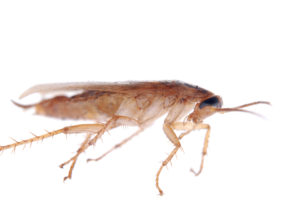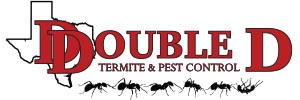
German
Adult German cockroaches are light brown except for the shield behind the head marked with two dark stripes, which run lengthwise on the body, and about 5/8 inch long. Young roaches are wingless and nearly black with a single light stripe running down the middle of the back. Egg capsules are light tan.
German cockroaches, are the most common roaches found in houses and restaurants. Most cockroaches have a flattened, oval shape, spiny legs, and long, filamentous antennae. Immature stages are smaller, have undeveloped wings and resemble the adults. They eat food of all kinds and may hitchhike into the house on egg cartons, soft drink cartons, sacks of potatoes or onions, used furniture, beer cases, etc.
They can develop into large populations and live throughout the house, especially in the kitchen and bathroom. During the day, these roaches may be found hiding clustered behind baseboard molding, in cracks around cabinets, closets or pantries, and in and under stoves, refrigerators and dishwashers. When seen during the day in clusters, the population is large.
Roaches can foul food, damage wallpaper and books, eat glue from furniture, and produce an unpleasant odor. Some homeowners are allergic to roaches. The pests can contaminate food with certain bacterial diseases that result in food poisoning, dysentery, or diarrhea.
American
American cockroaches are reddish brown and have a yellowish margin on the body region behind the head. They are usually around 1 and 1/2 inches long. When disturbed, may run rapidly and adults may fly. Immature cockroaches resemble adults except that they are wingless.
American cockroaches generally live in moist areas, but can survive in dry areas if they have access to water. They prefer warm temperatures around 84 degrees Fahrenheit and do not tolerate cold temperatures. In residential areas, these cockroaches live in basements and sewers, and may move outdoors into yards during warm weather. These cockroaches are common in basements, crawl spaces, cracks and crevices of porches, foundations, and walkways adjacent to buildings. They feed on a wide variety of plant and animal material.
Oriental
The Oriental cockroach known as the “water bug,” is more closely associated with damp areas than the other common roaches. These insects feed on garbage and decaying organic matter and are often considered the filthiest of the house-infesting roaches. They are found in damp basements, cellars, crawl spaces, near drains, leaky water pipes and beneath refrigerators, sinks and washing machines, under floors, and inside walls. They forage mostly on first floors of buildings.
Outdoors, they are found beneath decomposing leaves or stones in mulching materials, in trash and at municipal sewer plants. During the autumn, there can be a mass movement into buildings, but because of their preference for cooler temperatures, can be found outdoors and in unheated buildings during the winter.
Adult Oriental cockroaches are shiny, dark brown or black, about 1 to 1-1/4-inch long and have nonfunctional wings incapable of flight. Females are about 1-1/4-inch long, broad and have only little pads for wings. Males are about one inch long, more slender and have wings not reaching the tip of the abdomen. Immature roaches (nymphs) are darker in color than adults, similarly shaped and wingless. Egg cases are dark reddish-brown, one inch long (largest of the common roaches), and appear slightly inflated.
Brown Banded
The adults are rather small cockroaches about 5/8 inch long. The adult male is slender in appearance with its wings extending beyond the tip of the abdomen. Adult females have shorter wings that expose a considerable portion of their broad abdomens. They have two light yellow or cream-colored bands across their backs. These bands tend to be hidden by the wings in the adults. The markings of the brown-banded cockroach are roughly crosswise while those of the German cockroach are lengthwise.
Brown-banded cockroaches are generally found on ceilings, high on walls, behind picture frames, and near motors of refrigerators and other appliances. They are also found in light switches, closets and furniture. They do not require as much moisture as the German cockroach which explains why they normally are found in rooms other than the kitchen or bathroom. These cockroaches dislike light and are not normally seen during the day.
Smokybrown Cockroach
Smokybrown cockroaches are 1 to 1-1/4 inches long when mature, uniformly dark-brown-to-mahogany, and characterized by fully developed wings that completely cover their abdomens. The pronotum (i.e., shield like area behind the head) is black. Nymphs are red brown; the younger ones have white markings on their backs and the first four or five segments of their antennae are white at the tip. The purse-shaped egg capsule (i.e., aotheca) is dark brown-to-black, 3/8-inch long, and typically has 10 to 14 eggs per side.
During her lifetime, the female smokybrown cockroach produces approximately ten egg capsules, each of which contains about 20 eggs. Using secretions from her mouth, the female firmly attaches the egg cases to some surface or object and covers them with surrounding materials. Nymphs emerge in 50 days and molt 10-12 times. Depending on temperature, development from egg to adult requires from 160 to 716 days. Adult females live an average of 218 days and males about 215 days.
Smokybrown cockroaches typically are outdoor pests commonly found in southern states as far as central Texas. Outdoors they often are found in wood piles, flower planters, palm trees, water oaks, and vacant buildings. Indoors they seek warm, humid areas without air circulation, such as garages, attics, and crawlspaces. Smokybrown cockroaches have also been found established in northern states, typically in greenhouses. These cockroaches are strong fliers and are attracted to lights.
Have a pest problem that we haven’t covered here? Just give a call at 1-817-558-PEST (7378) and talk to a Double D representative, or
- You can send us a e-mail.
